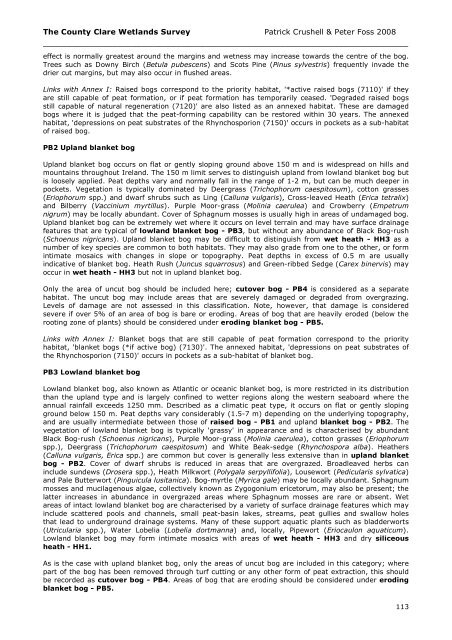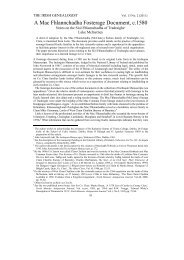Report Cover Vol I - Clare County Library
Report Cover Vol I - Clare County Library
Report Cover Vol I - Clare County Library
You also want an ePaper? Increase the reach of your titles
YUMPU automatically turns print PDFs into web optimized ePapers that Google loves.
The <strong>County</strong> <strong>Clare</strong> Wetlands Survey Patrick Crushell & Peter Foss 2008<br />
_______________________________________________________________<br />
effect is normally greatest around the margins and wetness may increase towards the centre of the bog.<br />
Trees such as Downy Birch (Betula pubescens) and Scots Pine (Pinus sylvestris) frequently invade the<br />
drier cut margins, but may also occur in flushed areas.<br />
Links with Annex I: Raised bogs correspond to the priority habitat, '*active raised bogs (7110)' if they<br />
are still capable of peat formation, or if peat formation has temporarily ceased. 'Degraded raised bogs<br />
still capable of natural regeneration (7120)' are also listed as an annexed habitat. These are damaged<br />
bogs where it is judged that the peat-forming capability can be restored within 30 years. The annexed<br />
habitat, 'depressions on peat substrates of the Rhynchosporion (7150)' occurs in pockets as a sub-habitat<br />
of raised bog.<br />
PB2 Upland blanket bog<br />
Upland blanket bog occurs on flat or gently sloping ground above 150 m and is widespread on hills and<br />
mountains throughout Ireland. The 150 m limit serves to distinguish upland from lowland blanket bog but<br />
is loosely applied. Peat depths vary and normally fall in the range of 1-2 m, but can be much deeper in<br />
pockets. Vegetation is typically dominated by Deergrass (Trichophorum caespitosum), cotton grasses<br />
(Eriophorum spp.) and dwarf shrubs such as Ling (Calluna vulgaris), Cross-leaved Heath (Erica tetralix)<br />
and Bilberry (Vaccinium myrtillus). Purple Moor-grass (Molinia caerulea) and Crowberry (Empetrum<br />
nigrum) may be locally abundant. <strong>Cover</strong> of Sphagnum mosses is usually high in areas of undamaged bog.<br />
Upland blanket bog can be extremely wet where it occurs on level terrain and may have surface drainage<br />
features that are typical of lowland blanket bog - PB3, but without any abundance of Black Bog-rush<br />
(Schoenus nigricans). Upland blanket bog may be difficult to distinguish from wet heath - HH3 as a<br />
number of key species are common to both habitats. They may also grade from one to the other, or form<br />
intimate mosaics with changes in slope or topography. Peat depths in excess of 0.5 m are usually<br />
indicative of blanket bog. Heath Rush (Juncus squarrosus) and Green-ribbed Sedge (Carex binervis) may<br />
occur in wet heath - HH3 but not in upland blanket bog.<br />
Only the area of uncut bog should be included here; cutover bog - PB4 is considered as a separate<br />
habitat. The uncut bog may include areas that are severely damaged or degraded from overgrazing.<br />
Levels of damage are not assessed in this classification. Note, however, that damage is considered<br />
severe if over 5% of an area of bog is bare or eroding. Areas of bog that are heavily eroded (below the<br />
rooting zone of plants) should be considered under eroding blanket bog - PB5.<br />
Links with Annex I: Blanket bogs that are still capable of peat formation correspond to the priority<br />
habitat, 'blanket bogs (*if active bog) (7130)'. The annexed habitat, 'depressions on peat substrates of<br />
the Rhynchosporion (7150)' occurs in pockets as a sub-habitat of blanket bog.<br />
PB3 Lowland blanket bog<br />
Lowland blanket bog, also known as Atlantic or oceanic blanket bog, is more restricted in its distribution<br />
than the upland type and is largely confined to wetter regions along the western seaboard where the<br />
annual rainfall exceeds 1250 mm. Described as a climatic peat type, it occurs on flat or gently sloping<br />
ground below 150 m. Peat depths vary considerably (1.5-7 m) depending on the underlying topography,<br />
and are usually intermediate between those of raised bog - PB1 and upland blanket bog - PB2. The<br />
vegetation of lowland blanket bog is typically 'grassy' in appearance and is characterised by abundant<br />
Black Bog-rush (Schoenus nigricans), Purple Moor-grass (Molinia caerulea), cotton grasses (Eriophorum<br />
spp.), Deergrass (Trichophorum caespitosum) and White Beak-sedge (Rhynchospora alba). Heathers<br />
(Calluna vulgaris, Erica spp.) are common but cover is generally less extensive than in upland blanket<br />
bog - PB2. <strong>Cover</strong> of dwarf shrubs is reduced in areas that are overgrazed. Broadleaved herbs can<br />
include sundews (Drosera spp.), Heath Milkwort (Polygala serpyllifolia), Lousewort (Pedicularis sylvatica)<br />
and Pale Butterwort (Pinguicula lusitanica). Bog-myrtle (Myrica gale) may be locally abundant. Sphagnum<br />
mosses and mucilagenous algae, collectively known as Zygogonium ericetorum, may also be present; the<br />
latter increases in abundance in overgrazed areas where Sphagnum mosses are rare or absent. Wet<br />
areas of intact lowland blanket bog are characterised by a variety of surface drainage features which may<br />
include scattered pools and channels, small peat-basin lakes, streams, peat gullies and swallow holes<br />
that lead to underground drainage systems. Many of these support aquatic plants such as bladderworts<br />
(Utricularia spp.), Water Lobelia (Lobelia dortmanna) and, locally, Pipewort (Eriocaulon aquaticum).<br />
Lowland blanket bog may form intimate mosaics with areas of wet heath - HH3 and dry siliceous<br />
heath - HH1.<br />
As is the case with upland blanket bog, only the areas of uncut bog are included in this category; where<br />
part of the bog has been removed through turf cutting or any other form of peat extraction, this should<br />
be recorded as cutover bog - PB4. Areas of bog that are eroding should be considered under eroding<br />
blanket bog - PB5.<br />
113
















